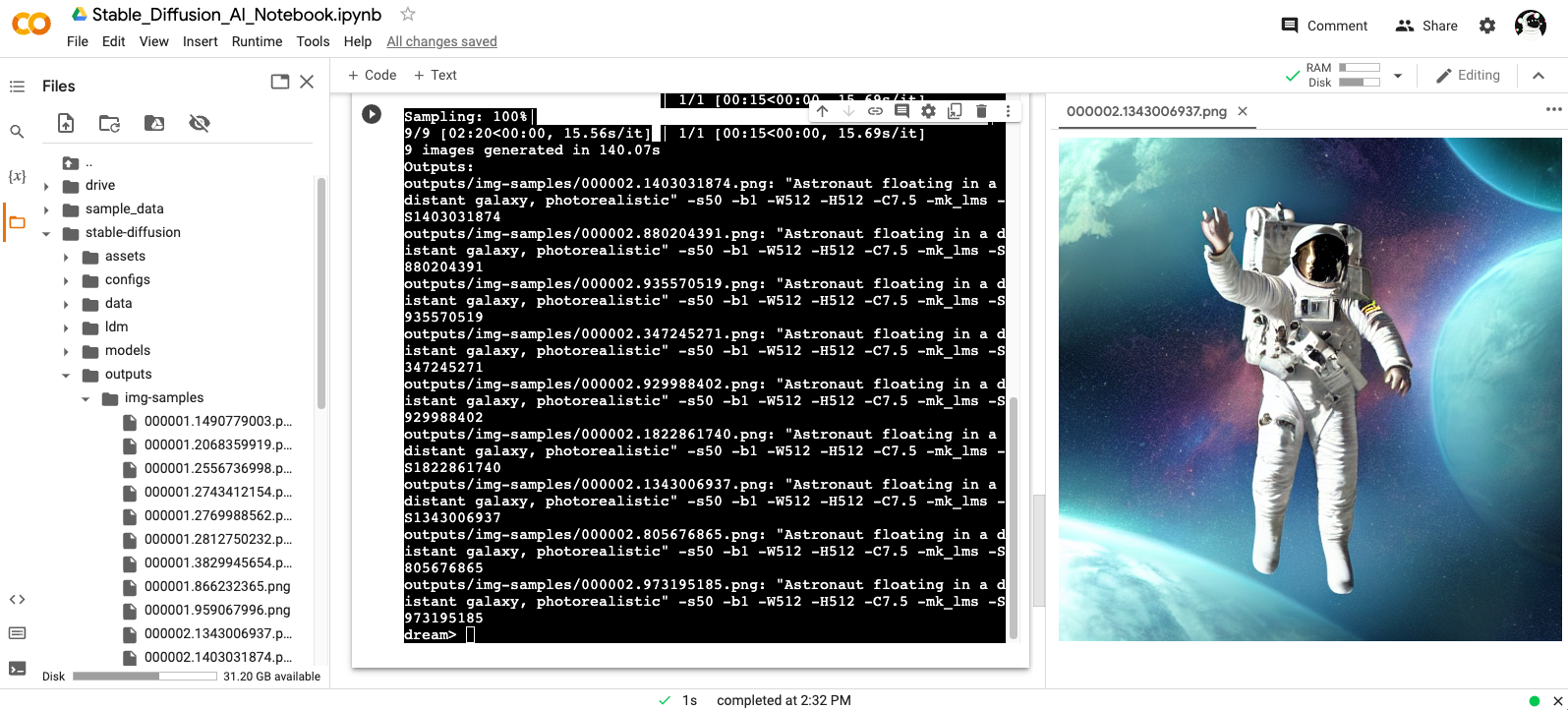6.7 KiB
Google Colab
Stable Diffusion AI Notebook:
Open and follow instructions to use an
isolated environment running Dream.
Seamless Tiling
The seamless tiling mode causes generated images to seamlessly tile
with itself. To use it, add the --seamless option when starting the
script which will result in all generated images to tile, or for each
dream> prompt as shown here:
dream> "pond garden with lotus by claude monet" --seamless -s100 -n4
Reading Prompts from a File
You can automate dream.py by providing a text file with the prompts
you want to run, one line per prompt. The text file must be composed
with a text editor (e.g. Notepad) and not a word processor. Each line
should look like what you would type at the dream> prompt:
a beautiful sunny day in the park, children playing -n4 -C10
stormy weather on a mountain top, goats grazing -s100
innovative packaging for a squid's dinner -S137038382
Then pass this file's name to dream.py when you invoke it:
(ldm) ~/stable-diffusion$ python3 scripts/dream.py --from_file "path/to/prompts.txt"
You may read a series of prompts from standard input by providing a filename of -:
(ldm) ~/stable-diffusion$ echo "a beautiful day" | python3 scripts/dream.py --from_file -
Shortcuts: Reusing Seeds
Since it is so common to reuse seeds while refining a prompt, there is now a shortcut as of version 1.11. Provide a **-S** (or **--seed**)
switch of -1 to use the seed of the most recent image generated. If you produced multiple images with the **-n** switch, then you can go back further using -2, -3, etc. up to the first image generated by the previous command. Sorry, but you can't go back further than one command.
Here's an example of using this to do a quick refinement. It also illustrates using the new **-G** switch to turn on upscaling and face enhancement (see previous section):
dream> a cute child playing hopscotch -G0.5
[...]
outputs/img-samples/000039.3498014304.png: "a cute child playing hopscotch" -s50 -W512 -H512 -C7.5 -mk_lms -S3498014304
# I wonder what it will look like if I bump up the steps and set facial enhancement to full strength?
dream> a cute child playing hopscotch -G1.0 -s100 -S -1
reusing previous seed 3498014304
[...]
outputs/img-samples/000040.3498014304.png: "a cute child playing hopscotch" -G1.0 -s100 -W512 -H512 -C7.5 -mk_lms -S3498014304
Weighted Prompts
You may weight different sections of the prompt to tell the sampler to attach different levels of
priority to them, by adding :(number) to the end of the section you wish to up- or downweight.
For example consider this prompt:
tabby cat:0.25 white duck:0.75 hybrid
This will tell the sampler to invest 25% of its effort on the tabby cat aspect of the image and 75% on the white duck aspect (surprisingly, this example actually works). The prompt weights can use any combination of integers and floating point numbers, and they do not need to add up to 1.
Thresholding and Perlin Noise Initialization Options
Two new options are the thresholding (--threshold) and the perlin noise initialization (--perlin) options. Thresholding limits the range of the latent values during optimization, which helps combat oversaturation with higher CFG scale values. Perlin noise initialization starts with a percentage (a value ranging from 0 to 1) of perlin noise mixed into the initial noise. Both features allow for more variations and options in the course of generating images.
For better intuition into what these options do in practice, here is a graphic demonstrating them both in use. Perlin noise at initialization is varied going across by 0.0, 0.1, 0.2, 0.4, 0.5, 0.6,, 0.8, 0.9, 1.0; and the threshold is varied going down from 0, 1, 2, 3, 4, 5, 10, 20, 100. The other options are fixed, so the initial prompt is as follows:
a portrait of a beautiful young lady -S 1950357039 -s 100 -C 20 -A k_euler_a --threshold 0 --perlin 0
Note: currently the thresholding feature is only implemented for the k-diffusion style samplers, and empirically appears to work best with k_euler_a and k_dpm_2_a. Using 0 disables thresholding. Using 0 for perlin noise disables using perlin noise for initialization. Finally, using 1 for perlin noise uses only perlin noise for initialization.
Simplified API
For programmers who wish to incorporate stable-diffusion into other products, this repository includes a simplified API for text to image generation, which lets you create images from a prompt in just three lines of code:
from ldm.generate import Generate
g = Generate()
outputs = g.txt2img("a unicorn in manhattan")
Outputs is a list of lists in the format [filename1,seed1],[filename2,seed2]...].
Please see ldm/generate.py for more information. A set of example scripts is coming RSN.
Preload Models
In situations where you have limited internet connectivity or are blocked behind a firewall, you can use the preload script to preload the required files for Stable Diffusion to run.
The preload script scripts/preload_models.py needs to be run once at
least while connected to the internet. In the following runs, it will
load up the cached versions of the required files from the .cache
directory of the system.
(ldm) ~/stable-diffusion$ python3 ./scripts/preload_models.py
preloading bert tokenizer...
Downloading: 100%|██████████████████████████████████| 28.0/28.0 [00:00<00:00, 49.3kB/s]
Downloading: 100%|██████████████████████████████████| 226k/226k [00:00<00:00, 2.79MB/s]
Downloading: 100%|██████████████████████████████████| 455k/455k [00:00<00:00, 4.36MB/s]
Downloading: 100%|██████████████████████████████████| 570/570 [00:00<00:00, 477kB/s]
...success
preloading kornia requirements...
Downloading: "https://github.com/DagnyT/hardnet/raw/master/pretrained/train_liberty_with_aug/checkpoint_liberty_with_aug.pth" to /u/lstein/.cache/torch/hub/checkpoints/checkpoint_liberty_with_aug.pth
100%|███████████████████████████████████████████████| 5.10M/5.10M [00:00<00:00, 101MB/s]
...success
